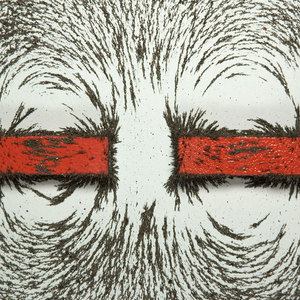Feb. 23, 2007 Research Highlight Physics / Astronomy
Flipping spins create unusual quantum phase
Mathematical model prompts investigations of solid helium
 Figure 1: Charged particle spins of a bar magnet generate a magnetic field.
Figure 1: Charged particle spins of a bar magnet generate a magnetic field.
Ordinary matter can be classified into three different phases—solid, liquid or gas—depending on how its atoms and molecules are arranged. But scientists are now discovering a whole range of different ‘quantum’ phases in the subatomic world.
Tsutomu Momoi, a theoretical physicist at RIKEN’s Discovery Research Institute in Wako, and colleagues in France and the UK have devised mathematical models that could show experimental physicists where to look for new types of quantum phases1, 2.
Unlike conventional phases of matter, quantum phases differ not in the positions of their constituent particles, but in the distribution of the quantum properties (such as spin) that each particle possesses.
When a charged particle spins, it generates a magnetic field that can point ‘up’ or ‘down’, just like the north and south poles of a bar magnet (Fig. 1). Neighboring particles prefer to alternate their magnetic poles to minimize the repulsion between them. But when three magnetic particles are fixed in a triangle, it is impossible for each one to have the opposite polarity to both its neighbor: the system is said to be frustrated.
In some materials, spins constantly fluctuate as they try to accommodate their neighbors, even at the coldest possible temperature. Momoi and colleagues have created a mathematical model of one such ‘spin liquid’ where four particles flip their spins, one after another in a never-ending cycle, in order to ease their frustration.
Unusually, these spins can be arranged at more subtle angles than simply ‘up’ or ‘down’. “New degrees of freedom come out instead,” says Momoi.
The team found that the new spin arrangements are carried by a trio of magnons, a type of quantum particle that describes the spread of magnetic disorder through a system. “Usually magnons scatter each other, but we found that these three magnons form a bound state,” explains Momoi.
This produces a magnetic field within the quantum phase which has eight poles, a hidden degree of freedom that has never been investigated before, says Momoi.
The model suggests that experimental physicists could actually find these effects in solid films of helium-3 atoms. “Finding new phases gives us the chance of creating a new frontier of physics,” he adds. “Understanding how to control them will be useful in developing technology of magnetic materials in future.”
References
- 1. Momoi, T., Sindzingre, P. & Shannon, N. Octupolar order in the multiple spin exchange model on a triangular lattice. Physical Review Letters 97, 257204 (2006). doi: 10.1103/PhysRevLett.97.257204
- 2. Shannon, N., Momoi, T. & Sindzingre, P. Nematic order in square lattice frustrated ferromagnets. Physical Review Letters 96, 027213 (2006). doi: 10.1103/PhysRevLett.96.027213
